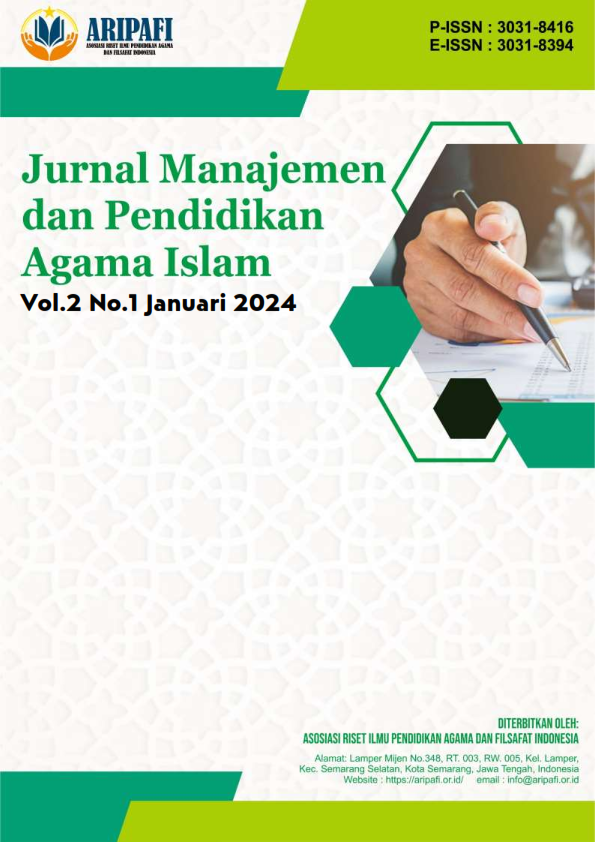Implementasi Metode Iqra’ Dalam Meningkatkan Pengenalan Huruf Hijaiyyah Pada Anak Usia Dini Di TK Az-Zahra Mondang
DOI:
https://doi.org/10.61132/jmpai.v2i1.114Keywords:
Iqra' Method, Introduction to Hijaiyyah Letters, Az-Zahra Mondang KindergartenAbstract
Based on the results of research carried out by the author, it can be concluded that (1) The ability to recognize hijaiyyah letters in early childhood at the Az-Zahra Mondang Kindergarten has not yet developed (BB) as much as 1 child or 4.17%, the ability to recognize hijaiyyah letters in early childhood begins Developing (MB) 11 children or 45.83%, the ability to recognize hijaiyyah letters in early childhood Develops According to Expectations (BSH) 10 children or 41.67%, while the ability to recognize hijaiyyah letters in early childhood Develops Very Well (BSB) 2 children or 8.33%. (2) The ability to recognize hijaiyyah letters in early childhood using the iqra' method at Az-Zahra Mondang Kindergarten in cycle I classically, namely Not Yet Developed (BB) there are no children, the ability to recognize hijaiyyah letters in early childhood Begins to Develop (MB) 7 children or 29.17%, the ability to recognize hijaiyyah letters in early childhood is developing according to expectations (BSH) 12 children or 50.00%, while the ability to recognize hijaiyyah letters in early childhood is developing very well (BSB) 5 children or 20.83%. In cycle II, classically, namely Not Yet Developed (BB) there were no children, the ability to recognize hijaiyyah letters in early childhood began to develop (MB) 1 child or 4.17%, the ability to recognize hijaiyyah letters in early childhood Developed According to Expectations (BSH) 10 children or 41.67%, while the ability to recognize hijaiyyah letters in early childhood is developing very well (BSB) for 13 children or 54.17%. So it can be concluded that implementing the iqra' method can increase the recognition of hijaiyyah letters in early childhood at Az-Zahra Mondang Kindergarten.
Downloads
References
Arif, I. (2020). Model-Model Pembelajaran Mutakhir. Pustaka Pelajar.
Arikunto, S. dkk. (2015). Penelitian Tindakan Kelas. Bumi Aksara.
Budiyanto. (2019). Prinsip-prinsip Metodologi Buku Iqro’. Team Tadarus AMM.
Fatkiyah, F. (2019). Implementasi Metode Iqra’ dalam Peningkatan Kemampuan Membaca dan Aktifitas Pembelajaran Al-Qur’an Studi Kasus di Kelas II SD Negeri 2 Wates Kulon Progo Semester I Tahun Pelajaran 2018/2019. El-Tarbawi, 12. https://doi.org/10.20885/tarbawi.vol12.iss1.art7
Fazil, M. (2020). Efektivitas Penggunaan Metode Iqra’ Untuk Meningkatkan Kemampuan Membaca Al-Qur’an Bagi Siswa Muallaf. Tadabbur: Jurnal Peradaban Islam, 2. https://doi.org/10.22373/tadabbur.v2i1.29
Halik, A. (2022). Efektifitas Penerapan Metode Iqro’ Dalam Meningkatkan Kemampuan Santri Dalam Membaca Al-Qur’an Di Tpa Bustanuddin Desa Galis Kecamatan Galis Pamekasan. Jurnal Pemikiran, Pendidikan Dan Penelitian Ke-Islaman, 8. http://journal.uim.ac.id/index.php/ahsanamedia
Humam, A. (2019). Buku Iqro’ Cara Cepat Belajar Membaca Al-Qur’an. Team Tadarus.
Juanda, A. (2016). Penelitian Tindakan Kelas (Classroom Action Research). CV Budi Utama. https://www.ptonline.com/articles/how-to-get-better-mfi-results
Kemendikbud. (2008). Kamus Bahasa Indonesia.
Kurnaedi, A. Y. (2021). Metode Asy-Syafi’i: Cara Praktis Baca Al-Qur’an. Pustaka Imam Asy-Syafi’i.
Kuswoyo. (2018). Metode Iqra’ KH. As’ad Humam Perspektif Behavioristik. UIN Sunan Kalijaga.
Nizar, R. dan S. (2019). Filsafat Pendidikan Islam. Kalam Mulia.
Sulistya, M. dan pamuji. (2019). Metode Iqro ’ Terhadap Kemampuan Membaca Huruf Hijaiyyah Anak Autis Diajukan kepada Universitas Negeri Surabaya Metode Iqro ’ Terhadap Kemampuan Membaca Huruf Hijaiyyah Anak Autis. Jurnal Pendidikan Khusus, 8.
Suryabrata, S. (2019). Psikologi Pendidikan. Raja Grafindo Persada.
Ulfah, T. T. dkk. (2019). Implementasi Metode Iqro’ dalam Pembelajaran Membaca Al-Qur’an. Jurnal Ta’dibuna Pendidikan Agama Islam Yokyakarta, 2.
Downloads
Published
How to Cite
Issue
Section
License
Copyright (c) 2024 Jurnal Manajemen dan Pendidikan Agama Islam

This work is licensed under a Creative Commons Attribution-ShareAlike 4.0 International License.





